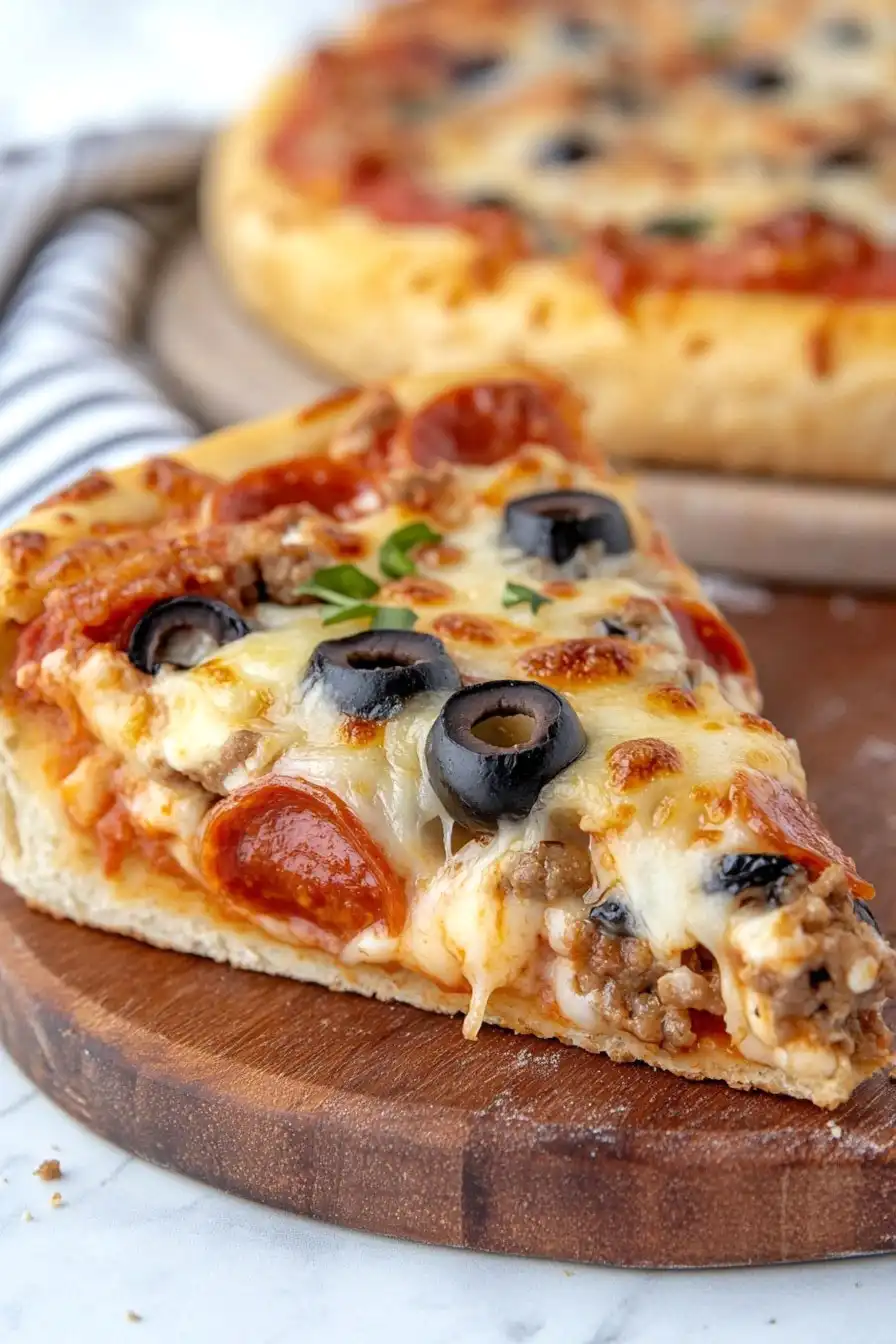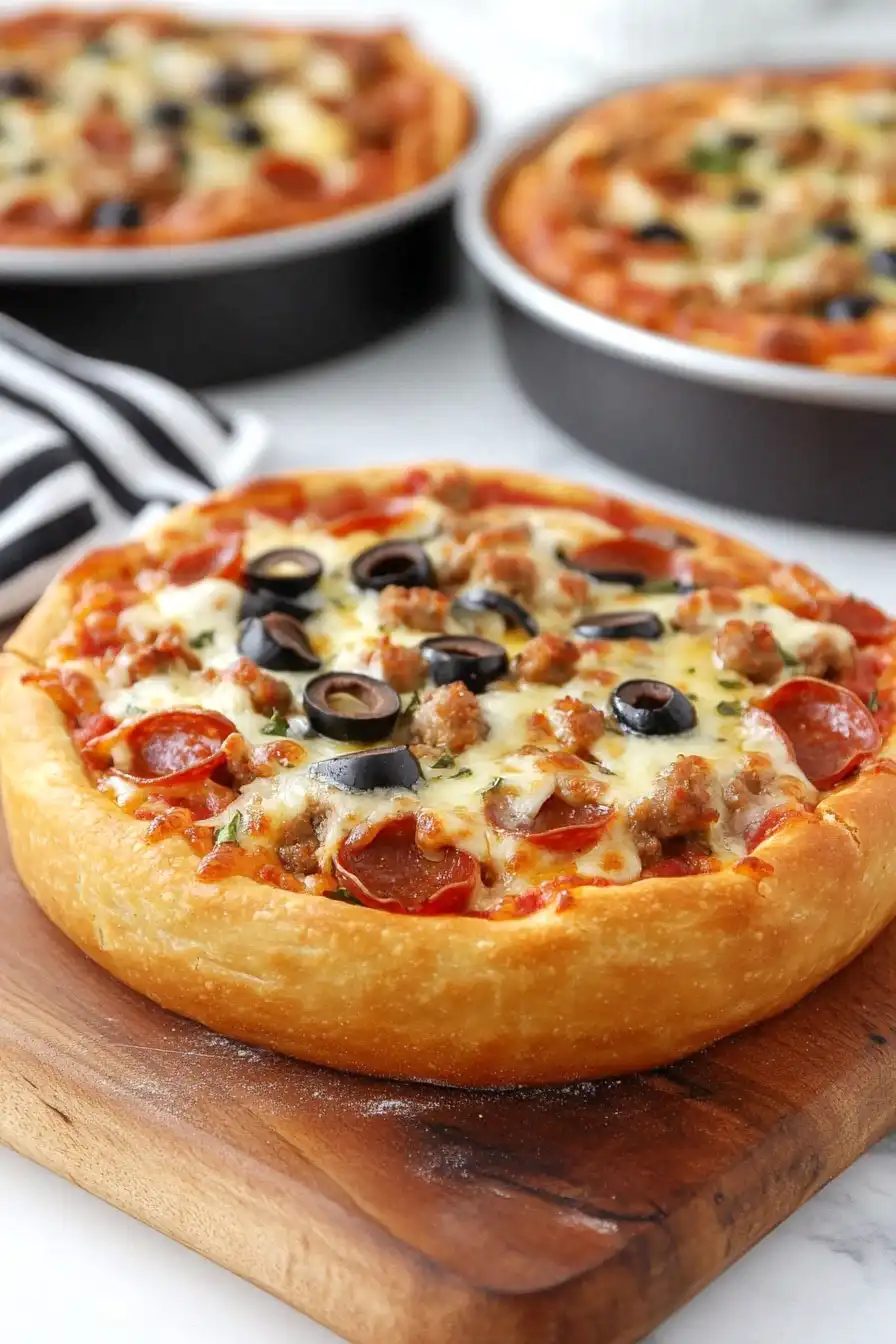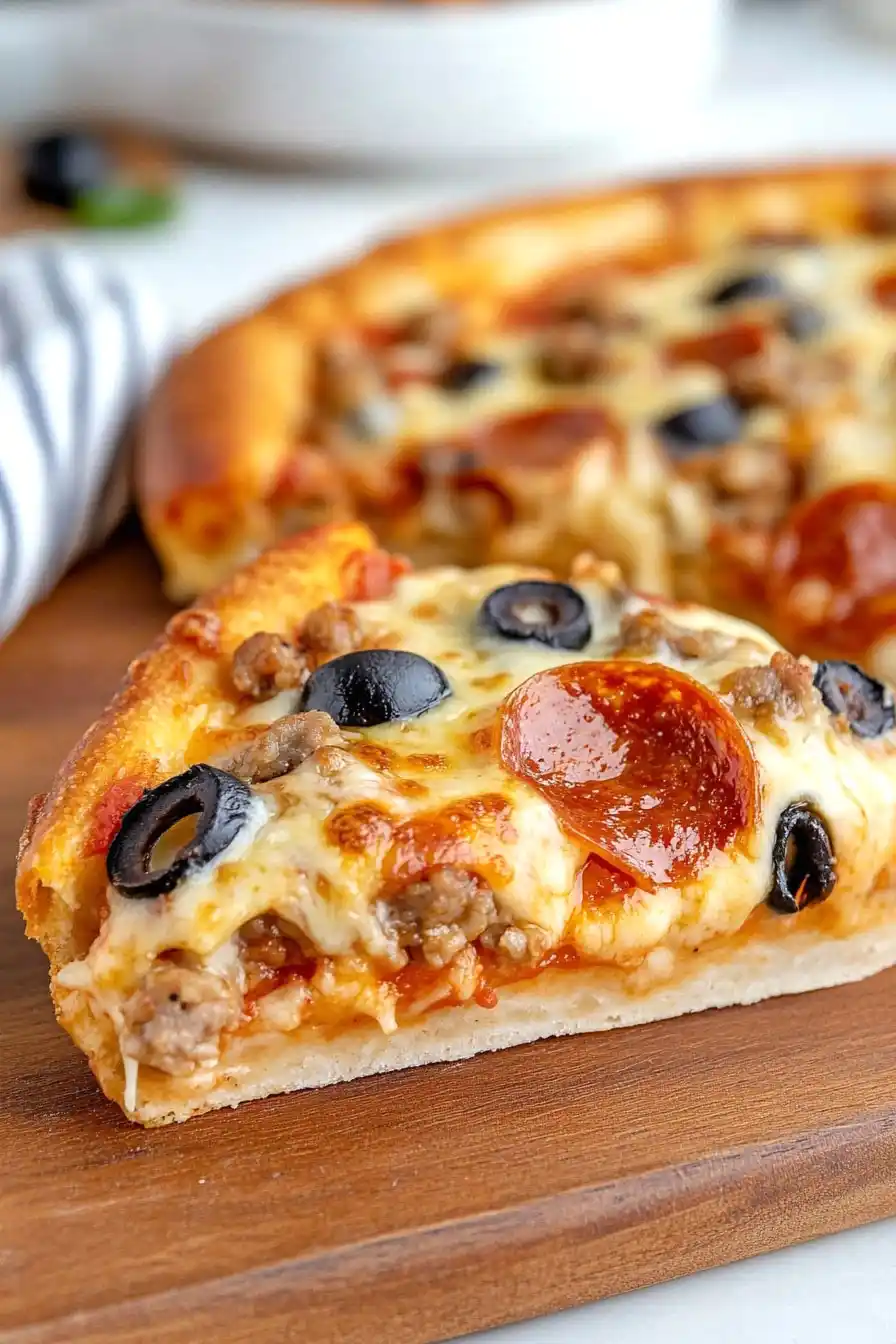Growing up, I always thought pizza was something you could only get from restaurants. My mom would order it for special occasions, and Pizza Hut was our go-to spot. I never imagined I could make that thick, chewy crust at home.
But here’s the thing – making Pizza Hut-style dough isn’t as complicated as I once thought. While most homemade pizza recipes give you a thin, crispy crust, this copycat version creates that soft, pillowy texture we all remember from those family pizza nights. And the best part? You don’t need any fancy equipment or special skills to make it happen.

Why You’ll Love This Pizza Dough
- Restaurant-quality results – This copycat Pizza Hut dough recipe gives you that classic pan pizza texture – crispy on the outside and soft on the inside – just like you’d get from the restaurant.
- Budget-friendly – Making pizza dough at home costs a fraction of what you’d spend on takeout, using basic pantry ingredients you likely already have.
- Customizable – Once you master this base recipe, you can top your pizza with anything you like – from classic pepperoni to creative combinations of your favorite ingredients.
- Make-ahead friendly – You can prepare this dough in advance and keep it in the fridge, making it perfect for busy weeknight dinners or weekend pizza parties.
- Foolproof recipe – With simple ingredients and clear steps, this recipe works every time – even if you’re new to making homemade pizza dough.
What Kind of Flour Should I Use?
For this Pizza Hut-style dough, regular all-purpose flour is your best bet, though bread flour can work too if you’re after a chewier crust. While you might be tempted to use whole wheat flour for a healthier twist, stick to all-purpose flour for that authentic pizzeria taste and texture. The protein content in all-purpose flour (usually around 10-12%) gives you just the right amount of gluten development for that perfect balance of crispy and chewy. When measuring your flour, try to avoid scooping directly with the measuring cup – instead, spoon the flour into the cup and level it off with a knife for the most accurate measurement.

Options for Substitutions
Making this pizza dough at home? Here are some helpful substitutions if you’re missing ingredients:
- All-purpose flour: You can use bread flour for a chewier crust, or substitute up to 1 cup of whole wheat flour for a healthier option. Just note that using whole wheat will make the crust slightly denser.
- Non-fat dry milk powder: If you don’t have milk powder, you can replace the water and milk powder with 1 1/3 cups of warm whole milk. For a dairy-free version, use warm water and skip the milk powder altogether.
- Active dry yeast: Instant yeast works just as well – use the same amount but you can skip the proofing step. If using fresh yeast, use about 2.5 times the amount.
- Olive oil: Any neutral cooking oil like canola or vegetable oil will work fine in the dough and for greasing the pan.
- Mozzarella cheese: Feel free to mix in or substitute with other melting cheeses like provolone, monterey jack, or a pizza cheese blend. For dairy-free options, plant-based mozzarella alternatives work too.
- Garlic: Fresh and powdered garlic are interchangeable here – if you’re out of both, you can use 1/2 teaspoon of garlic salt and reduce the regular salt in the recipe.
Watch Out for These Mistakes While Making
The temperature of your water is crucial when working with yeast – if it’s too hot (over 115°F) you’ll kill the yeast, and if it’s too cold (below 95°F) the dough won’t rise properly, so use a thermometer to get that perfect lukewarm temperature around 105°F. A common mistake is rushing the rising process – your dough needs at least 1-2 hours to rise in a warm spot until it doubles in size, and skipping this step will result in a dense, tough crust instead of that signature Pizza Hut fluffiness. When kneading the dough, avoid adding too much extra flour even if it feels sticky at first – over-flouring will make your crust heavy and brick-like, instead give it time to come together naturally during the kneading process. For the best results, oil your hands lightly instead of using flour when handling the dough, and remember to let the dough rest for 15-20 minutes after punching it down and before shaping it into your pan – this final rest helps prevent the dough from shrinking back while you’re trying to stretch it.

What to Serve With Pizza?
A homemade pizza night calls for some tasty sides that complement all that cheesy, saucy goodness! A simple green salad with Italian dressing helps cut through the richness of the pizza and adds a fresh element to your meal. If you’re feeding a crowd, consider putting together some garlic knots using extra pizza dough, or whip up some crispy buffalo wings for that authentic pizzeria experience. For a lighter option that still feels special, try roasting some seasonal vegetables with olive oil and Italian herbs – they’ll taste great alongside your freshly baked pizza.
Storage Instructions
Store Dough: After kneading, you can keep the pizza dough in the fridge for up to 3 days. Just place it in a bowl covered with plastic wrap or in an airtight container. The slow fermentation in the fridge actually helps develop more flavor – it’s like a happy accident!
Freeze: This dough is perfect for freezing! Divide it into individual portions, wrap each one in plastic wrap, and pop them in a freezer bag. They’ll stay good for up to 3 months. When you’re craving pizza, just move a portion to the fridge the night before you plan to use it.
Make Ahead: Want to prep ahead? You can make this dough up to 24 hours before you need it. After the first rise, punch it down and store it in the fridge. Just remember to let it come to room temperature for about 30 minutes before shaping your pizza – this makes it much easier to work with!
| Preparation Time | 30-45 minutes |
| Cooking Time | 15-20 minutes |
| Total Time | 75-105 minutes |
| Level of Difficulty | Medium |
Estimated Nutrition
Estimated nutrition for the whole recipe (without optional ingredients):
- Calories: 3000-3500
- Protein: 90-110 g
- Fat: 150-180 g
- Carbohydrates: 350-400 g
Ingredients
For the dough:
- 1/2 tsp salt
- 1 packet active dry yeast (about 2 1/4 tsp)
- 2 tbsp olive oil
- 1 1/3 cups lukewarm water (about 105°F for activating yeast)
- 4 cups all-purpose flour (I use King Arthur all-purpose flour)
- 1 tbsp granulated sugar
- 1/4 cup dry milk powder
For assembling and baking:
- pizza toppings
- 12 oz shredded mozzarella cheese (full-fat for best melt)
- 6 tbsp olive oil (or vegetable oil, for greasing pans)
- pizza sauce (store-bought or homemade)
For the crust finish:
- 4 tbsp butter (melted)
- 1 tbsp minced garlic (freshly minced for best flavor)
Step 1: Prepare the Yeast Mixture
In a measuring cup or small bowl, combine yeast, sugar, and dry milk with warm water.
Stir well and allow the mixture to proof for about 5 minutes, or until it becomes foamy and bubbly.
This step ensures that the yeast is active and ready to work its magic on your dough.
Step 2: Make the Dough
In a large mixing bowl, combine the oil, flour, and salt.
Pour in the foamy yeast mixture and stir until combined.
Once mixed, turn the dough out onto a flat surface and knead for about 10 minutes until it becomes smooth and elastic.
Alternatively, you can use a stand mixer with a dough hook attachment to knead the dough.
Step 3: Prepare Pans and Dough Balls
Divide the dough into three equal balls.
In each of three 8-inch cake pans (or alternatively, one 8-inch pie plate and one 9×13-inch dish), add 2 tablespoons of oil and spread it evenly across the surface.
Using a rolling pin, roll out each dough ball to about an 8-inch circle, then place each one into the prepared pans.
Step 4: Allow the Dough to Rise
Cover each pan with a plate or a towel and allow the dough to rise in a warm place for 1 to 1 1/2 hours, or until the dough has doubled in size.
This step is crucial for achieving a light and airy pizza crust.
Step 5: Add Sauce and Toppings
After the dough has risen, spoon 1/3 cup of sauce onto each pizza, spreading it to within 1 inch of the edge.
Next, evenly distribute 3 ounces of shredded mozzarella cheese on each pizza.
Add your favorite toppings, such as sausage or pepperoni, then sprinkle an additional 1 ounce of mozzarella cheese on top.
Step 6: Bake and Finish
Preheat your oven to 450 degrees Fahrenheit.
Once preheated, place the pizzas in the oven and bake until the cheese is bubbling and the outer crust is golden brown, approximately 15 minutes.
While the pizzas are baking, combine melted butter with garlic and let it sit for 20 minutes to infuse the garlic flavor.
Once the pizzas are done, brush the outer edge of the crust with the garlic butter for an extra burst of flavor.
Serve hot and enjoy your homemade delicious pizzas!

